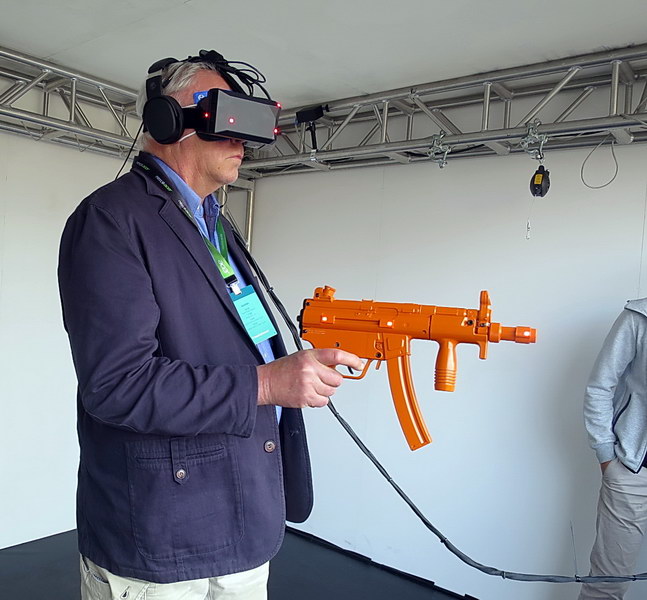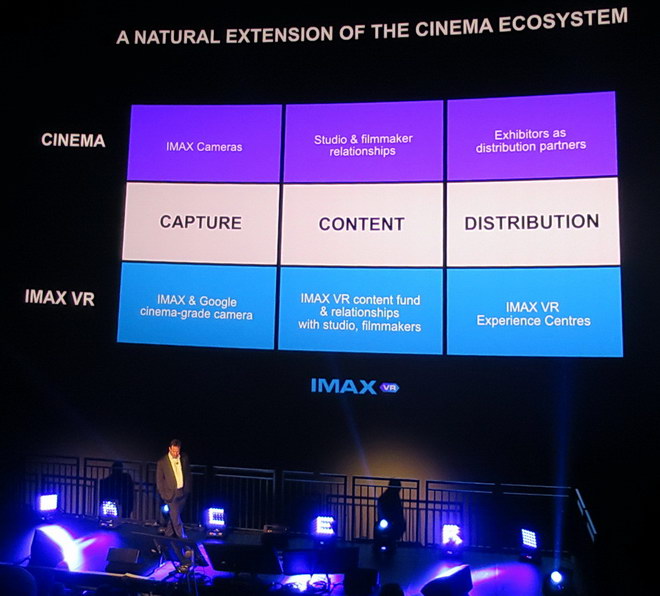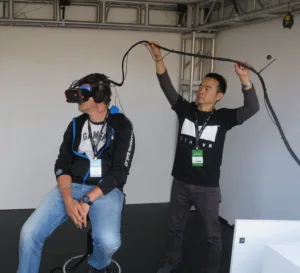On Thursday April 27thAcer had its annual Next@Acer product introduction and technology event at the IMax theater on Broadway at 67th Street in New York. This theater has the largest screen of any IMax theater in the world and is driven by a 6P laser projection system. This very immersive large, curved screen was a good reference for the VR/AR/MR discussions to follow.
Two products Acer showed were the StarVR HMD and an Acer-branded mixed reality headset, both of which I will talk about in this Display Daily. Other new products introduced at Next@Acer are discussed in a separate article, “Next@Acer Showcases New Products and Technology” (subscription required).
At the 2016 Next@Acer event, Acer showcased four different dedicated VR headsets (subscription required.), including the Oculus Rift headset from Oculus, Open Source Virtual Reality’s OSVR headset, HTC’s Vive and Starbreeze Studios StarVR headset. One reason all these headsets were there last year was to prove that any of the Acer Predator-series gaming computers with Nvidia graphics could drive virtually any VR HMD. This compatibility can pretty much now be taken as a given.
I tried all four headsets last year and found the StarVR unit by far the best, primarily because it used two high resolution displays to significantly reduce (but not eliminate) the visibility of individual pixels and sub-pixels. This high resolution coupled with the very wide field of view of the StarVR unit pushed VR further along towards the “Reality” end of the experience spectrum. Of course, a two-display HMD has problems of it’s own, including weight, bulk and an insatiable thirst for data plus a relatively high power consumption that will make it difficult to eliminate the tether.
The heavy tether on the StarVR HMD needed an aide to keep it from interfering with the demo. (Photo: M. Brennesholtz)
 Meko’s Matt Brennesholtz playing a first person shooter game while wearing the StarVR HMD. Note the camera in the background tracking the LEDs on the HMD and gun. This experience is also available at the IMax VR Center in Los Angeles. (Photo: M. Brennesholtz)
Meko’s Matt Brennesholtz playing a first person shooter game while wearing the StarVR HMD. Note the camera in the background tracking the LEDs on the HMD and gun. This experience is also available at the IMax VR Center in Los Angeles. (Photo: M. Brennesholtz)
Since then, Acer has made a significant investment in Starbreeze (at least $9M), and the Acer/Starbreeze Studios joint venture is now called the StarVR Corporation. Not surprisingly, there were no headsets from Oculus, OSVR or HTC at this year’s Next@Acer conference. The StarVR units at Next@Acer 2016 had obviously been demonstration units. Bo Andersson, Chairman of StarVR Corporation and Brooks Brown, Leading Content and Strategy at the company, spoke at Next@Acer and said the unit shown in 2017 was a “development kit available to select partners”. Clearly, IMax is one of those partners and, presumably, a very important one.
The StarVR HMD still isn’t perfect and clearly the image isn’t “Reality.” Pixels are still visible, the unit is tethered, limiting the freedom of movement of the wearer and it needed separate headphones for audio. In addition, the unit will not accommodate glasses and there was no diopter adjustment in the system. On the other hand, the latency when your head moved was low and the field of view (FOV) covered virtually the entire human FOV, making the experience quite immersive.
The unit was being demonstrated in two “Pods,” one with a high resolution 360° image and the other with a first person shooter game. I tried both and the unit, heavy as it was, was comfortable and provided very good images. Recently I’ve seen several demos of VR applications where the HTC Vive was used and the StarVR unit blew that HMD away, at least in terms of image quality. Since the StarVR is not commercially available, the other companies I visited and giving the demos were forced to show their demos on the Vive.
 Rob Lister from IMax discussing IMax’s movement into VR, with his graphics on the giant, curved IMax screen behind him. (Photo: M. Brennesholtz)
Rob Lister from IMax discussing IMax’s movement into VR, with his graphics on the giant, curved IMax screen behind him. (Photo: M. Brennesholtz)
Rob Lister, Chief Business Development Officer at IMax Corporation, discussed the IMax plan to move into “Premium, location-based virtual reality experience centers.” He said this was “a natural extension of the [IMax] cinema ecosystem,” and would include capture, content creation and distribution of VR content.
IMax already has one IMax VR Center in Los Angeles. There are 8 different VR experiences, each in its own “Pod”. IMax uses both StarVR and HTC Vive HMDs in different pods for different experiences. Experiencing IMax VR isn’t cheap: it costs “$7-10 for around 5-10 minutes of VR fun” according to Digital Trends, or $25 for the 8th pod, a VR sampler pack. IMax plans to open five more VR centers in the coming months.
Mark Bolas, Director of Program Management, Windows Mixed Reality at Microsoft, shared with the audience how the Microsoft Hololens platform blends physical and digital worlds to produce new mixed reality (MR) environments. This software platform is used by Acer in its own-brand HMD that was released to developers in March. Acer expects to ship it’s Windows Mixed Reality Headsets (no Acer part number or name is available yet) for consumers and commercial customers later this year. This unit, like the StarVR, uses one imager per eye and had fairly good resolution and very little latency. The primary source of latency in a VR system is in the image processing and Acer has very powerful gaming computers designed to provide lightning-fast graphics. The displays were 1440 x 1440 LCDs, each 2” (51mm) square.
I got to try the Acer HMD under the guidance of a one-on-one discussion with Greg Sullivan, Director and Senior Marketing Manager at Microsoft. He said the Microsoft Hololens platform has been available for several years now and it’s first commercial application was in a automotive head-up display (HUD). He said the Hololens platform runs on a Windows 10 platform, not really a surprise. The software was released to HMD developers last June and the Acer HMD is the first unit demonstrated that runs with the Hololens platform. Sullivan said four other companies are also developing MR HMDs around Hololens-based software, including Asus, Dell, HP and Lenovo. He expects that all five companies will have consumer products in time for Christmas 2017. He couldn’t reveal the Acer MSRP but said at least one HMD from one of the five manufacturers would be at a retail price of $299.
 The Acer/Hololens HMD in the down position (left) and the up position (right). (Photo: M. Brennesholtz)
The Acer/Hololens HMD in the down position (left) and the up position (right). (Photo: M. Brennesholtz)
Strictly speaking, the Acer HMD is a VR unit, not a MR unit. It completely blocks the wearer’s view of the external world and does not blend the image from a camera into the displayed VR/AR image. Presumably, this will be a capability of the next-generation of Acer HMD and will take advantage of more of the capabilities of the Microsoft Hololens software. The unit is MR only in the sense that the optical system flips up to allow the wearer to see the real world without taking the unit off. Then it flips down so the wearer can see the displays. In the up position, the HMD significantly restricts the wearers FOV. Like the StarVR unit, this is also tethered, not wireless. At Next@Acer 2016, the company discussed a backpack VR computer that would allow a VR HMD user to be untethered, even if the user needs to carry the computer with him. There was no sign of this computer at Next@Acer 2017, nor any mention of it.
While I was waiting for my scheduled turn to see the StarVR and Acer HMD demos, I wandered back into the IMax theater. First, they were using the 6P projector to show a 30 second time-lapse loop of Acer setting up this year’s Next@Acer show, including the crane that lifted much of the equipment up to the 8th floor terrace. Next they showed The Fate of the Furious (AKA Furious 8). As you can see from what I watched while in the line, I had to wait a while for my demos. Unfortunately, the IMax images were less impressive than they could have been because they had the house lights on so workers could disassemble the equipment from the show. Still, it was impressive. I’ll have to go back to see a 3D show there with the house lights off and get 6P Laser Cinema in it’s full glory. – Matthew Brennesholtz

